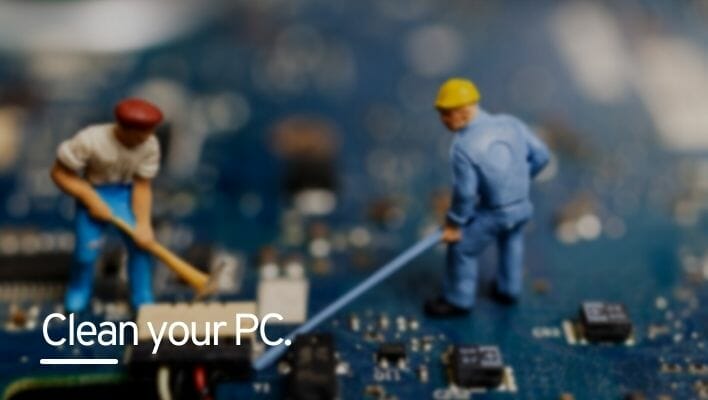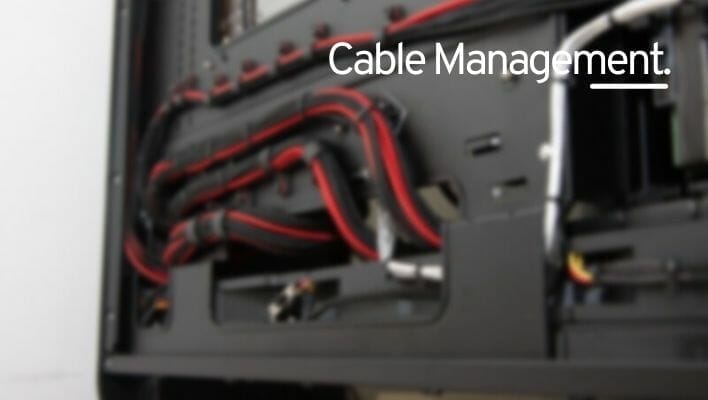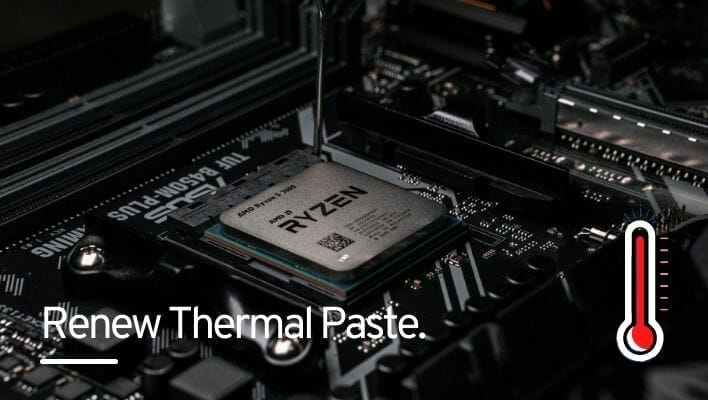The most daunting thing to happen on a computer can be overheating. We should always avoid running our computer components in extreme measures of heat. Any electronic component, including computer parts cannot work optimally when exposed to increased temperatures. More crucially when the temperatures reacher the higher slabs, they can even ultimately fail the hardware component completely.
Similar, or more sensitive is the case with the CPU. It is imperative to assure that your CPU is running within a reasonable range of temperature.
What happens when a CPU overheats?
In today’s age, the newest computers are designed in a way that the system shuts when a CPU approaches a specified threshold temperature to prevent it from going up in fumes. Actually, this ensures that your computer is saved from further harm.
Another big reason for keeping the CPU temperature low or in check is that it also endangers the motherboard.
Despite the shutting down mechanism, overeating affects computer components, leads to reduced performance, and eventually absolute collapse of the computer. It is general with almost all electronic devices that less the temperature, the better the performance.
The most common reasons for the temperature increases are prolonged power consumption from the CPU or poor airflow.
Easy Steps to Reduce CPU Temperature:
We should always keep our CPU temperature in check because it is the key to our computer’s performance. To dodge this issue we wrote this article which demonstrates the ‘striking ways in which you can reduce your computer’s temperature’.
Solution 1: Ensure Better Airflow.

It is one of the most handful of ways to reduce your CPU temperature. Steady airflow inside your computer and around the CPU is mighty effective. Inside a computer case, different computer parts run in parallel and invariably give off heat which collectively builds up into a situation of overheating.
To avoid this scenario we must opt for a neutral airflow, this can be achieved by allocating intake fans and exhaust fans at opposite ends of the case. It is factored on your chassis whatever the case may be, you must always allow a good airflow mechanism.
Few tips to keep in mind,
- Ensure the Fans Placed Correctly: Placing the fans to perfection is an art, almost all fans can work as an intake or outtake airflow option. So setting up the fan’s airflow correctly plays an important role in securing the lower CPU or overall temperature.
- Mechanism: Ensuring a general flow of air is important, when installing fans, reflect on how they will work collectively. Guarantee that the general flow is not hindered. Generally, PC cases come with suggestions for airflow in the instruction manual and those suggestions are worth considering.
- Use Larger Fans: Solely depending on your computer size, but it is recommended to use larger fans which results in reduced RPM, heat, and noise.
Solution 2: Clean your Computer.
Technically speaking a clean computer will also ensure an improved airflow. A clean computer will allow air to flow more smoothly and the dust won’t get cluttered.
Cleaning your computer case is divided into two phases:
- Cleaning the Case.
- Cable Management.
Equipment Required:
for this whole activity, you would need several things such as compressed air, a vacuum cleaner, microfiber cloth, dust mask, cable ties, and a softer paintbrush.
Cleaning the PC Case:

A clean machine will see an instant drop in temperature measures, especially if you haven’t done it for a while. Basically, the internals of a computer gets dustier with time as fans continuously push and pull air, they typically gather dust.
This results in dust settling on parts, and with time the components get clogged with dust and eventually become stunted and ineffective. Regularly cleaning your fans and other components can keep them fresh and working wonderfully.
But there is nothing to worry about because you can clean your computer in few easy steps:
- Remove the covers from the case, basically opening your computer case.
- Clean the dust off your computer components using a vacuum cleaner or compressed air. (make sure you wear a dust mask and take necessary precautions)
- Clean your fans using compressed gas, vacuum cleaner, or cloth if possible however you should make sure that the fan doesn’t spin as it can damage its header. Also, clean the dust from the graphics card fan (if any) and PSU fan.
- Take off the dust around the casing walls using compressed air or a vacuum cleaner, specifically places where fans are placed.
- Place the covers back and close the case correctly. And it is recommended that you should keep the case at all times because a close case ensures good airflow; in contrast, an open case can allow more dust to enter the components.
Warning: Excessive amount of dust in your computer and inside the case, on fans could diminish airflow which will raise the temperatures inside the case and make your CPU temperature to the peak. And eventually affects the performance of your computer.
Cable Management:

People usually don’t consider tidy cable management as a potential solution to bad airflow. The point is that the cables take a large mass of space resulting in bad airflow.
Maintaining your computer cables is not a part of aesthetics but is effective as it provides a large amount of space for airflow.
If you haven’t managed your cables in a while, this is the right time to revisit, most modern computers come with specified cable management compartments and for others, cable ties would do a great deal.
Solution 3: Check or Upgrade your Cooling Components.
If your computer is neat and the airflow is good enough but still you’re suffering from higher temperature and overheating issues. In that scenario, a component upgrade is on the cards. However, it is not always a CPU cooler that needs a change, it can be a case fan, your PSU unit, or a thermal compound. You should always check on your CPU cooler and make sure that it is working appropriately.
if not! go for a new CPU Cooler best fitted to do the job for you.
Get a New CPU Cooler:

CPU Coolers get older with time and hence do not performs on par. Branded coolers are considered qualified but with time they should be upgraded. be fine but they are not as efficient as an aftermarket CPU cooler or fan. Getting a powerful CPU cooler should be fancied especially if your CPU is overheating.
A new CPU cooler will surely provide a huge impact on CPU temperature and would be a justified investment given that your computer needs an uplift.
if you believe that your CPU cooler is working correctly then the second thought of consideration should be reapplying your thermals.
Renew Thermal Compound:

Reapplying the thermal compound mostly does the job. We recommend that using a better quality thermal paste will be wise. At times, thermal paste dries out and possesses a thread to the CPU chip. A better compound will ensure better outcomes in shifting heat between the CPU and the heatsink.
While it is important to renew the paste, but at the same point right amount of thermal paste should be used, and have to be careful with applying.
Another fix that you should fancy knowing that your CPU cooler and thermals are perfect, reviewing your computer fans or opting for a new case fan.
Checking the Fans:
So, here is another thing worth mentioning checking your fans that if they’re working ok?
You should review every fan on your computer, check if they’re working fine, is it working on fine RPM and there can be a thing that can be skipping its duty.
Therefore, replacing the old fans or investing in a new case fan can be life-saving. You will undoubtedly witness an elevation in cooling management.
If checking or adding few fans didn’t do any good, there is more to look forward to, and possibly that will sort things out for you!
Get a New CPU PSU:

A weak power supply unit can mess things up for you so it is required that you get a better power supply. Go for a modular PSU because that will ensure better airflow.
Make sure that you choose a power supply that perfectly suits your needs and is best suited for your computer.
Extra Tips & Tricks:
- Get a Laptop Cooler: If you’re a laptop user, and facing an overheating problem then go for an adapted laptop cooler that can keep your lap and laptop cool!
- Choose a Cool Operating Space: If your computer is facing overheating there can be a chance that you haven’t considered a cool place for your computer. Because higher temperatures can be triggered by the environment, look where your computer is positioned and remove any hindrances that restrain regular airflow. You should also keep your computer away from windows and vents if you reside in a warm place.
- Add Memory Cooling Fans: RAM overheating is possible because bad airflow can halt the memory sticks to operate at normal temperature. To improve cooling management add a cooling fan close to your memory sticks, which helps reduce the temperature in the memory area.
- Shift to Liquid Cooling: If you’re a gamer and using a gaming machine with overclocked components oftentimes the fans are not enough to handle the raised temperatures. To sort this out, you should opt for liquid cooling kits as means of heat management. And don’t get into the deception that liquid coolers are unsafe because liquid cooling kits are reliable, affordable, and absolutely safe.
- Exercise precautions while overclocking: Given that overclocking can maximize the performance of your computer and components, it also takes the fact that it forces your computer capabilities to the extra limits, which practically means higher temperatures. Despite, how you are overclocking your device, be sure that you take added precautions to ensure your components’ durability and effective cooling management persists.
FAQ:
1. How can we improve our PC performance?
At times a PC doesn’t perform up to mark, and it can be frustrating There are several ways in which you can fix a PC’s wicked performance.
- Uninstall Unnecessary Applications: Extra programs eat resources so it is a good practice to get rid of unneeded programs.
- Limit Startup Applications: Keeping a check on startup apps can be effective because the startup apps take a lot of resources depending on their usage.
- Expand Your Memory: Adding more RAM sticks can be a potential solution because RAM is the most crucial component for a PC’s performance and will definitely improve the performance.
- Scan your PC, check for viruses and malware. Because a virus-affected PC can be problematic and kills a PC’s performance.
- Perform a clean-up, or try disk defragmentation.
- Use SSD as your Boot Drive, Solid State Drives (SSDs) operates far faster than traditional Hard Drives and can be reliable, faster as compared to HDD.
- Upgrade your Windows: Updating your PC can sort out many problems, and at times in new revisions of Windows many problems are solved.
- If your PC is old, invest in a new machine.
2. What is the critical temperature for a CPU?
A critical temperature for a CPU depends on the CPU chip you’re using and the components it is matched with for example Heatsink, CPU Cooler, Thermals, and Fans.
Though, anything above 80 degrees level is unsafe, very critical for a CPU.
The moderate the temperature, the better will be your PC performance and basically, it all comes down to the components you’re using.
Closing Thoughts:
Talking about overheating, it is a serious concern and can cause damage to any computer. So, sorting this out is the need of the hour because extended use of a computer with overheating can cause the system to slow down and eventually fail. We talked about every possible resolution to this issue and this article will surely help you sort out this problem.
Keeping your computer cool ensures a steadfast computer as long as performance is concerned.
I hope this article guarantees a well-maintained computer in future. Thanks for reading, and believing that you find this post informative.
Related Articles
Quick and Easy Ways to Fix a Slow Computer
Best Motherboards for Ryzen 7 5800X
Best Motherboards for Intel 11th Gen Processors

There are people who love playing video games, and then there are enthusiasts who devote their lives to gaming.
Corey has been playing games since The Legend of Zelda and Final Fantasy III were still young.
Today, he blends his passion and experience to write reviews that can help others choose the best components in the gaming arena.
